

A solar cell is a device for converting energy from the sun into electricity. The high-efficiency solar cells you can buy at Radio Shack and other stores are made from highly processed silicon, and require huge factories, high temperatures, vacuum equipment, and lots of money.
If we are willing to sacrifice efficiency for the ability to make our own solar cells in the kitchen out of materials from the neighborhood hardware store, we can demonstrate a working solar cell in about an hour.
Our solar cell is made from cuprous oxide instead of silicon. Cuprous oxide is one of the first materials known to display the photoelectric effect, in which light causes electricity to flow in a material.
Thinking about how to explain the photoelectric effect is what led Albert Einstein to the Nobel prize for physics, and to the theory of relativity.
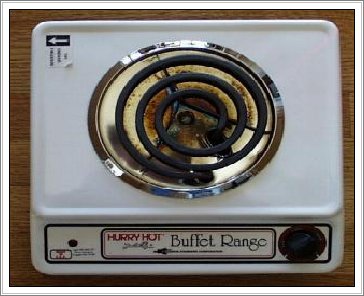
The first step is to cut a piece of the copper sheeting that is about the size of the burner on the stove. Wash your hands so they don't have any grease or oil on them.
Then wash the copper sheet with soap or cleanser to get any oil or grease off of it. Use the sandpaper or wire brush to thoroughly clean the copper sheeting, so that any sulphide or other light corrosion is removed. Next, place the cleaned and dried copper sheet on the burner and turn the burner to its highest setting.
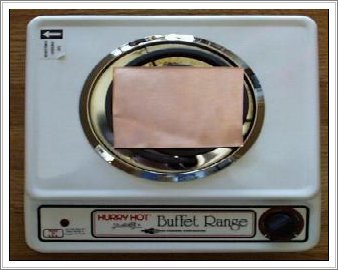
As the copper starts to heat up, you will see beautiful oxidation patterns begin to form. Oranges, purples, and reds will cover the copper.
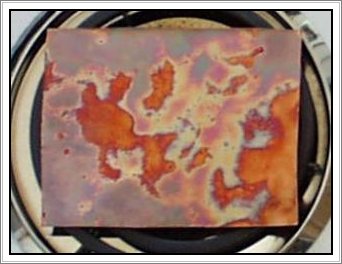
As the copper gets hotter, the colors are replaced with a black coating of cupric oxide. This is not the oxide we want, but it will flake off later, showing the reds, oranges, pinks, and purples of the cuprous oxide layer underneath.
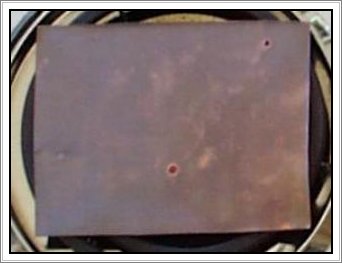
The last bits of color disappear as the burner starts to glow red.

When the burner is glowing red-hot, the sheet of copper will be coated with a black cupric oxide coat. Let it cook for a half an hour, so the black coating will be thick. This is important, since a thick coating will flake off nicely, while a thin coat will stay stuck to the copper.
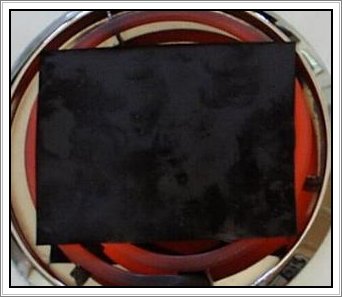
After the half hour of cooking, turn off the burner. Leave the hot copper on the burner to cool slowly. If you cool it too quickly, the black oxide will stay stuck to the copper.
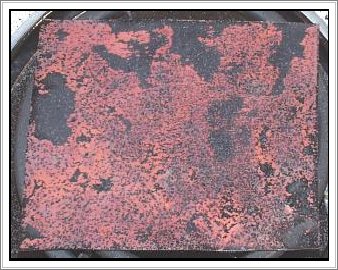
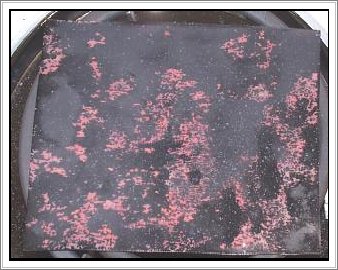
The little black flakes pop off the copper with enough force to make them fly a few inches. This means a little more cleaning effort around the stove, but it is fun to watch.
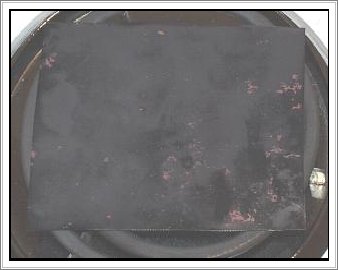
When the copper has cooled to room temperature (this takes about 20 minutes), most of the black oxide will be gone. A light scrubbing with your hands under running water will remove most of the small bits. Resist the temptation to remove all of the black spots by hard scrubbing or by flexing the soft copper. This might damage the delicate red cuprous oxide layer we need to make to solar cell work.
The rest of the assembly is very simple and quick. Cut another sheet of copper about the same size as the first one. Bend both pieces gently, so they will fit into the plastic bottle or jar without touching one another. The cuprous oxide coating that was facing up on the burner is usually the best side to face outwards in the jar, because it has the smoothest, cleanest surface.
Attach the two alligator clip leads, one to the new copper plate, and one to the cuprous oxide coated plate. Connect the lead from the clean copper plate to the positive terminal of the meter. Connect the lead from the cuprous oxide plate to the negative terminal of the meter.
Now mix a couple tablespoons of salt into some hot tap water. Stir the saltwater until all the salt is dissolved. Then carefully pour the saltwater into the jar, being careful not to get the clip leads wet. The saltwater should not completely cover the plates -- you should leave about an inch of plate above the water, so you can move the solar cell around without getting the clip leads wet.
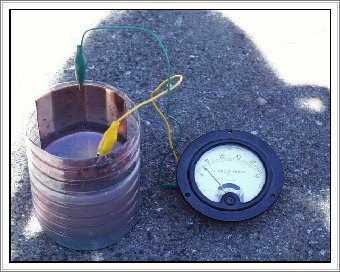
The photo above shows the solar cell in my shadow as I took the picture. Notice that the meter is reading about 6 microamps of current. The solar cell is a battery, even in the dark, and will usually show a few microamps of current.
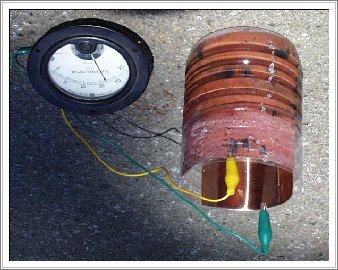
The above photo shows the solar cell in the sunshine. Notice that the meter has jumped up to about 33 microamps of current. Sometimes it will go over 50 microamps, swinging the needle all the way over to the right.
Cuprous oxide is a type of material called a semiconductor. A semiconductor is in between a conductor, where electricity can flow freely, and an insulator, where electrons are bound tightly to their atoms and do not flow freely.
In a semiconductor, there is a gap, called a bandgap between the electrons that are bound tightly to the atom, and the electrons that are farther from the atom, which can move freely and conduct electricity.
Electrons cannot stay inside the bandgap. An electron cannot gain just a little bit of energy and move away from the atom's nucleus into the bandgap. An electron must gain enough energy to move farther away from the nucleus, outside of the bandgap.
Similarly, an electron outside the bandgap cannot lose a little bit of energy and fall just a little bit closer to the nucleus. It must lose enough energy to fall past the bandgap into the area where electrons are allowed.
When sunlight hits the electrons in the cuprous oxide, some of the electrons gain enough energy from the sunlight to jump past the bandgap and become free to conduct electricity.
The free electrons move into the saltwater, then into the clean copper plate, into the wire, through the meter, and back to the cuprous oxide plate.
As the electrons move through the meter, they perform the work needed to move the needle. When a shadow falls on the solar cell, fewer electrons move through the meter, and the needle dips back down. Next: a flat panel solar cell.

New SOLAR CELLS
What is the [in situ] solar cell process?
That is the big breakthrough in solar cell design that drops the cost of solar power to $90 per kilowatt. Actually, the [in situ] (Latin for in place) technique is stunningly simple. Instead of refining the silicon and then building cells, you build the cells first and then refine the silicon.
The process generates a cell from ordinary beach sand (silicon dioxide). After cell fabrication, the sand is chemically treated. The reaction drives off the oxygen, leaving an almost pure polycrystalline silicon. Most conveniently. any remaining impurities rearrange themselves to form uniformly doped series connected p.n. junctions through a process celled Barefoot Layering. For each centimeter of cell thickness, you typically get several hundred series p.n. junctions or about 120 volts dc under normal sunlight. The thickness of the panel determines the voltage and the area the current. Typical current densities are four amperes per square meter of panel!
You can easily build a 100 watt cell. Simply take an ordinary metal cookie sheet, cover it uniformly with a 1 centimeter thick layer of beach sand, cover that with a piece of screening for the front collector, add a protective glass cover, and clamp everything together with large rubber bands, bungee cords, or something similar.
To do your final chemical refinement, carefully remove the glass cover and spray the sand with two liters of 3,7 Dimethylpentadecon-2-ol Propionate (available from larger organic chemical supply houses). [If any body finds a source for this let me know.] An ordinary window cleaner bottle makes a handy spray source. Reaction time is four hours, Since the reaction is photoisentropic It should be done under magenta safe light, such as that from a Portal Industries JJ-668 source.
The front terminal is positive and the greatest output will be obtained when the panel is pointed due south at an elevation of your latitude plus ten degrees. A group of panels can, of course, be wired in parallel for independent, on-site power.
Does any know the correct name of the chemical or is this thing a hoax.
Any one have any ideas,
Did the article appear in Popular Science and someone got the name wrong.
If it is a hoax its a pity I was willing to give this one a try.
Geoff
Dear Geoff,
If the chemical compound you are after is a sex pheromone of the pine
sawfly and normally used in picolitre quantities 2 litres would never be
affordable. It is not listed with any of the major chemical companies.
From some of the other stuff on the internet it maybe a pseudo hoax. a
lot of the stuff published on the internet is not scientifically
substantiated. Sorry.
Scott Mayfield
If anyone builds one of these situ solar cells let me know how you get on
Geoff
General Manager
Chem-Supply Pty Ltd
